
8 minute read
ART
ART
Traditions of ancestral art
Artist Pieper Bloomquist stands in her dining room near her wall-sized Swedish Bonadsmålning painting on canvas. She has studied Dalmålning (Kurbits) and Bonadsmålning with master artists Karen Jenson of Milan, MN, and Judith Kjenstad of Minneapolis, MN.

BY BAILEY HOVLAND| IMAGES PROVIDED COURTESY OF NORTH DAKOTA COUNCIL ON THE ARTS, TROYD GEIST, FOLKLORIST
Tine, Swedish Dala painting, acrylic on wood. Painted in Swedish style, this painted wooden ‘tine’ box measures 9 ½” by 7 ¾” across. A Scandinavian food storage container, they were often embellished in Norway and left plain in Sweden.

The upper Midwest has a history rich with Scandinavian traditions, evidenced by the stave churches scattered across the countryside and the names of small towns. Pieper Bloomquist is intimately familiar with this history, thanks to her upbringing in a Swedish household of rural Minnesota. Her childhood memories are laced with the warmth from her grandfather’s Swedish pancakes that she ate on the way to school and the Scandinavian designs on her mother’s coffee pot. Yet, Bloomquist’s awareness of the ancestral traditions and art in her life did not occur until later in life, when she began to see how her background was interwoven with different threads of her Swedish ancestry.
It was this interest in her family’s history, coupled with her passion for creating art, that led her to traditional Scandinavian folk art. “I was on bedrest in the ’90s while I was pregnant and my mom suggested I take up rosemaling. Little did we know that rosemaling
Kurbits, Swedish Dalmålning, 16” x 20”, acrylic on canvas. The artist’s personal style of light transparency is showcased in this painting.
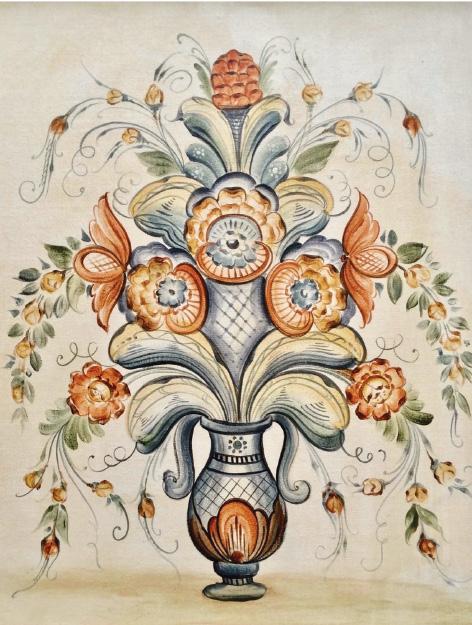
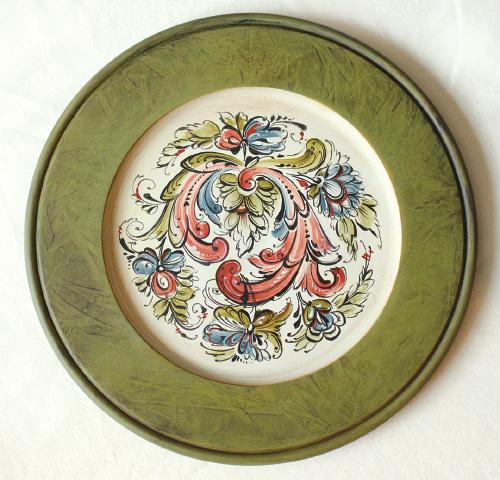
Norwegian Telemark Rosemaling, oil on wood: Authentic beauty is revealed in this 12” diameter painted wooden plate. Stylization learned from Judy Kjenstad.

Bjursås, Swedish Dalmålning, 12” x 16”, acrylic on canvas paper. Kurbits inspired by the painting that was done in the geographical parish of Bjursås, Sweden.
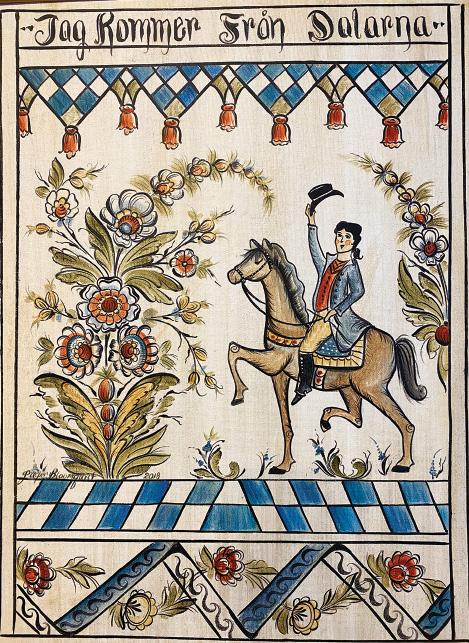
Jag Kommer Från Dalarna, Swedish Dalmålning, 16” x 20”, acrylic on canvas. Text reads: I Come from Dalarna.
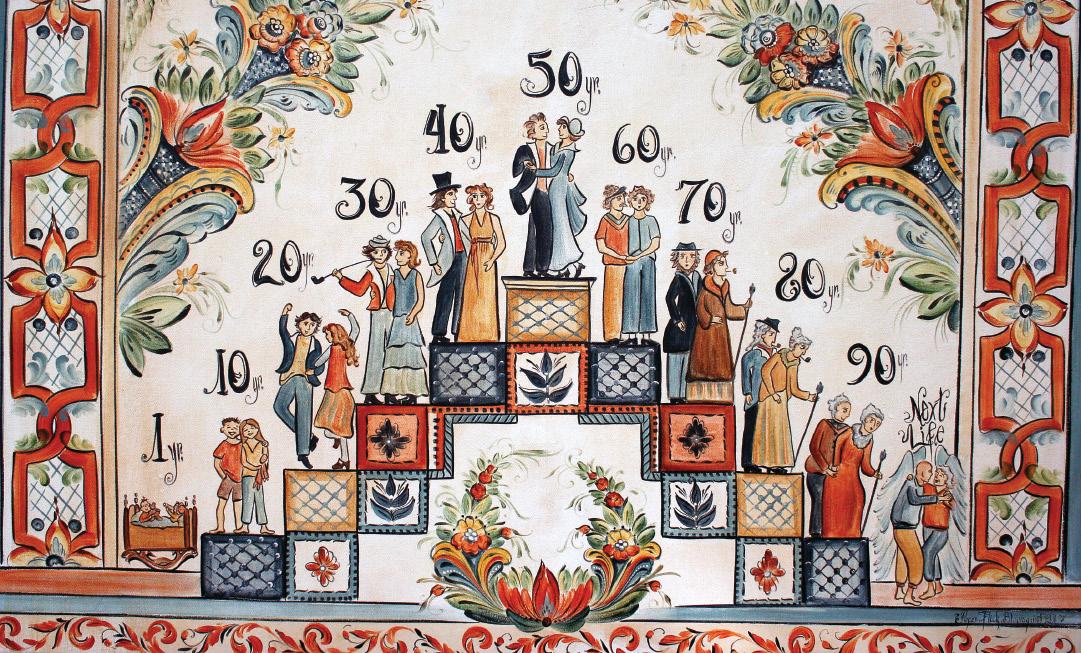
Stages of Life: Known for her illustrative story telling, this Dala painting by Bloomquist expresses the journey of life from birth to death.
is Norwegian,” Bloomquist said. Karen Jenson, internationally recognized for her rosemaling, taught Bloomquist the Norsk folk art. It was also through Jenson that Bloomquist discovered dalmålning and bonadsmålning, two styles of Swedish folk art. Dalmålning originated in central Sweden, functioning as wall-sized canvas paintings that emulated the large embroidered tapestries of churches and manor homes. Its free-flow designs embody the art of storytelling, giving a pigmented voice to allegories, news and biblical teachings. “I thought it was clumsy and weird and charming and ugly and darling and beautiful,” Bloomquist said. “I adored everything about it.” Bonadsmålning was born in southern Sweden, using horizontally long and narrow tapestries to narrate special occasions. Hung temporarily for special holidays and then stored under the floorboards until the next year, bonadsmålning pieces don’t have the same daily quality as their folk art counterparts.
Bloomquist has studied both art forms extensively and her experience is impressive: participating in the North Dakota Council on the Arts (NCDA) Folk Arts Apprenticeship program and studying as an apprentice under two Midwestern experts on Scandinavian folk art (Karen Jenson and Judith Kjenstad). Bloomquist is now a master artist and has taken on apprentices through the NDCA. In 2018, the American Scandinavian Foundation provided Bloomquist with a grant that allowed her to travel to Sweden with an apprentice to learn from local artists. Bloomquist takes these 18th-century art forms and spins them into modern tales, capturing the beauty of the upper Midwest.

Shown here is a close up of “Stages of Life”, a Dala painting depicting the lightheartedness and social norms of youth.

New Construction | Remodeling | Lake Homes | Wood Flooring Carpeting | Ceramic Tile | Window Blinds | Fabric Window Coverings


Sylvia Lunski Interior Designer
Christina Mehl Interior Designer Delrae Schefter Interior Designer
Sydney Ulrich Interior Designer
www.DesignDirectionFargo.com 701.365.4040 3211 Fiechtner Drive, Suite 1, Fargo, North Dakota

Shown here are the steady hands of apprentice Pieper Bloomquist creating traditional Swedish furniture paintings.
“My paintings often depict scenes that, while personal, portray the universal experiences of living in the upper Midwest. Creating scenes like these with traditional Swedish flowers and scroll formations connects me to my heritage and provides a kind of full circle effect for me,” Bloomquist said.
And the color scheme, drapery, ribbon style and shape of the leaves all indicate yet another layer of storytelling, revealing which area of Sweden the painting style hails from. Bloomquist uses these traditional geographic giveaways in her art, modernizing these practices. For example, Bloomquist’s painting of her hometown — Regal, Minnesota — is rich with the customary Rättvik style of red and olive green. Using the warm fall tones, she showcased the town’s golden wheat fields and fading green corn fields in the fall, the red of her childhood home
Although Bloomquist’s practice of Scandinavian folk art didn’t occur until the mid-’90s, painting has always been her emotional retreat. Her subjects then were “funky album covers,” like Led Zeppelin’s Houses of the Holy, and Christmas cards, taking inspiration from her daily life. This practice continues, as Bloomquist finds inspiration in the unlikeliest of places — in the patterns of hotel carpeting, the designs of white paper napkins, the scenes of holiday cards.
“I take my inspiration where I can get it," Bloomquist said. "I am always finding new ideas."
For more information on the North Dakota Council on the Arts Folk and Traditional Arts Apprenticeship Program contact tgeist@nd.gov.
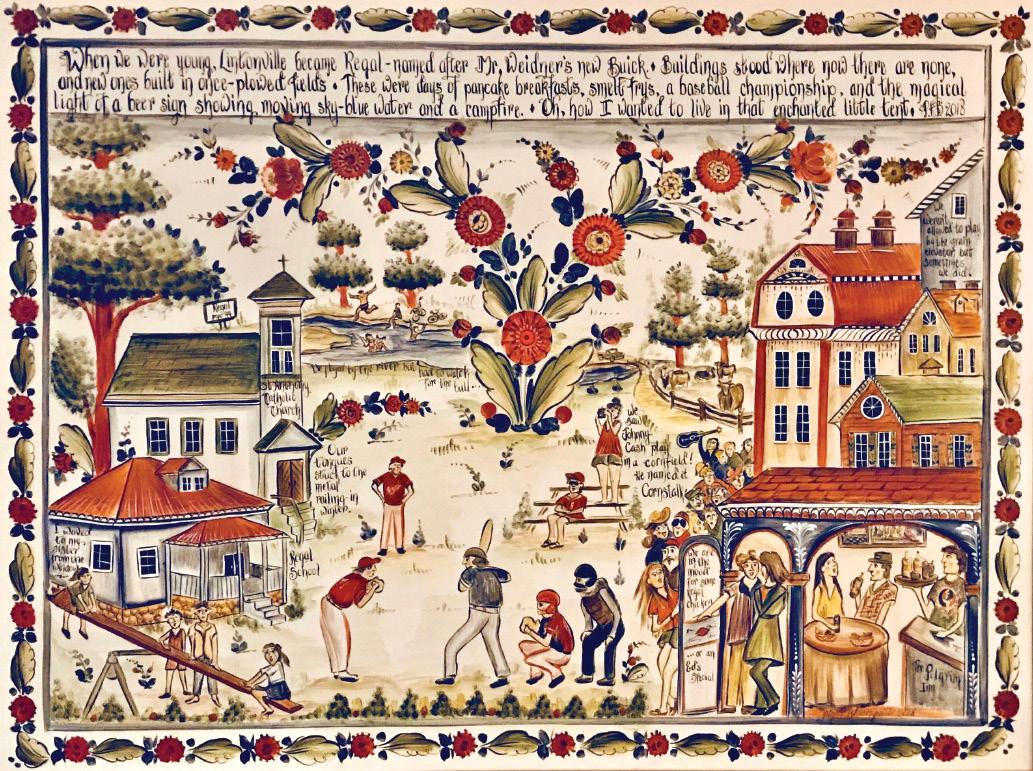
This Dala painting portrays Bloomquists love for her hometown of Regal, population of 44. It depicts a universal truth for all who live in small towns across the Midwest.

Trusted by Builders for 31 years




Home Organization For ANY Budget On Time Installations Guaranteed Bedrooms | Pantry | Storage







Ca us today to get started!
1821 26th Street South, Moorhead, Minnesota 218.233.4817 FREE ESTIMATES jlshelving.com SHOWROOM OPEN BY APPOINTMENT
Soy foods have a powerful nutritional profi le. High levels of healthy protein and fi ber | Essential vitamins and isofl avones | Gluten-free Excellent source of B vitamins, iron and phosphorus | Low in sodium and fat
Chicken and Cheese Quesadillas With Edamame Salsa
INGREDIENTS
Quesadillas 2 tbsp. vegetable oil 1 cup chopped onion 2 garlic cloves, minced 1 (8 ¾-ounce) can corn kernels, drained 2 cups shredded cooked chicken 1 ½ cups shredded Mexican four-cheese blend ¼ tsp. salt 6 7-8 inch fl our Tortillas
Salsa 2 cups frozen shelled edamame, divided 1 pint cherry tomatoes, quartered ¼ cup fi nely chopped red onion 1 tbsp. fresh lime juice 2 tbsp. chopped fresh cilantro ½ tsp. salt METHOD
Quesadillas Heat oil in large skillet over medium-high heat. Add the onion and garlic. Cook, stirring occasionally to soften, 2-3 minutes.
Add corn and ½ cup edamame, cook 2 minutes longer.
Transfer to a bowl and stir in chicken,
cheese and salt. Mix well. Spread the lower half of each tortilla with ½ cup of the chicken mixture.
Fold the top half of the tortilla over the fi lling to form a semi-circle. Repeat with remaining tortillas and chicken mixture.
Wipe skillet with a paper towel and return to stove, medium heat. Salsa Bring 2 quarts of lightly salted water to a boil in a medium saucepan over high heat. Add edamame, return to a boil and cook until tender, 6-7 minutes. Drain and rinse under cold water and drain again. Transfer 1- ½ cups edamame (reserving ½ cup to add to chicken and cheese mixture) to a bowl and stir in the tomatoes, onion, lime juice, cilantro and salt. Mix well and refrigerate until ready to serve.
Yields 6 (7-8 inch) quesadillas.
Nutritional analysis per serving: 486 Calories, 31 g Protein, 43 g Carbohydrates, 7 g Fiber, 22 g Fat, 9 g Saturated Fat

Add the quesadillas 2 at a time and cook 3-4 minutes per side or until lightly golden and hot.
Divide among 6 plates and top each with ½ cup of the edamame salad.

www.ndsoybean.com











